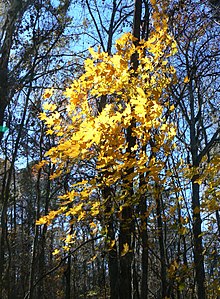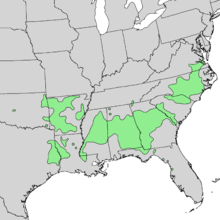Acer floridanum
| Acer floridanum | |
|---|---|
 |
|
| Young A. floridanum, about 4 m tall, showing color change. | |
| Scientific classification | |
| Kingdom: | Plantae |
| (unranked): | Angiosperms |
| (unranked): | Eudicots |
| (unranked): | Rosids |
| Order: | Sapindales |
| Family: | Sapindaceae |
| Genus: | Acer |
| Species: | A. floridanum |
| Binomial name | |
|
Acer floridanum (Chapm.) Pax |
|
 |
|
| Distribution | |
Acer floridanum (syn. Acer saccharum subsp. floridanum (Chapm.) Desmarais, Acer barbatum auct. non Michx.), commonly known as the Florida maple and occasionally as the southern sugar maple or hammock maple, is a tree that occurs in mesic and usually calcareous woodlands of the Atlantic and Gulf coastal plain in the United States, from southeastern Virginia in the north, south to central Florida, and west to Oklahoma and Texas.
It is a medium-sized to large deciduous tree, growing to 15–25 m (exceptionally to 38 m) tall, with an elliptical crown of moderate density with a smooth or rounded outline. The bark is a light gray with thick irregular curling ridges; as the tree matures, the bark tends to become plated. The twigs are slender, somewhat shiny, reddish brown. The terminal buds are sharply pointed, brown and pubescent. The leaves are opposite, simple, palmately lobed and veined, 3–9.5 cm long and 3.5–11 cm broad, with an entire margin and three or five somewhat rounded lobes, and a 2–8 cm long petiole. They are green above and paler and pubescent below. In fall they turn orange and yellow. The flowers are regular, pentamerous, and appear on yellow-green corymbs and are quite small. They hang from puberulent pedicels 2.4–5 cm long in clusters of a few flowers, appearing before or with the leaves in early spring. This is about two weeks prior to the maturation of the flowers of Acer saccharum. The tree is generally diecious, though they are often also polygamous, that is having bisexual and unisexual flowers on the same individual. The fruit is a paired samara 1.5–3 cm long.
...
Wikipedia

